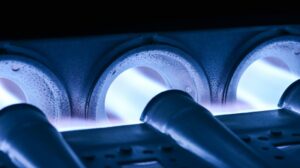 Are you utilizing a gas-powered heater this fall and winter to keep your home warm? This isn’t surprising, since after all this the most popular heating system found in modern homes. This is especially true in climates like ours that don’t have bitterly cold winters and so don’t need something like radiant heating or boiler heating.
Are you utilizing a gas-powered heater this fall and winter to keep your home warm? This isn’t surprising, since after all this the most popular heating system found in modern homes. This is especially true in climates like ours that don’t have bitterly cold winters and so don’t need something like radiant heating or boiler heating.
Furnaces are cost-efficient, and a fantastic choice for many homeowners. However, while they’re not inherently harmful, when you use natural gas in your home for any appliance, there is always a small risk of toxic gas leaks and combustion issues. The primary concern in avoiding issues like this is taking care of your furnace’s heat exchanger.
What Is the Heat Exchanger?
In short, a heat exchanger is the component that makes it possible for your furnace to actually heat the living space.
It’s a clam-shell designed metal chamber where combustion gas collects. As air from your blower fan moves over the heat exchanger, it picks up the radiation heat, and brings that heat into your home.
The intense heat that comes from the combustion gases collected in the heat exchanger raises the temperature of the metal walls. This makes the exterior of the heat exchanger really hot, allowing the furnace to apply the heat of the combustion gases to the air, but without letting these gases get into contact with the air.
What Causes Damage to the Heat Exchanger?
The heat exchangers inside furnaces go through a lot of strain throughout the winter, even in an area like ours. Every time a heat exchanger heats up, the metal expands. Then as the furnace cycles off and the heat exchanger cools down, it contracts. This constant movement of the metal weakens it and leads to corrosion.
This is, as you can probably guess, a bigger risk in an older furnace than it is a brand new one. It’s also a bigger risk in a furnace that doesn’t get routine annual maintenance. The corrosion will weaken the metal even more, and then the heat exchangers start developing small cracks that can be virtually invisible to the naked eye, but creates major problems for health and safety.
Why a Cracked Heat Exchanger Is a Problem
As we mentioned above, cracks on the heat exchanger can be pretty much invisible to the naked eye. In fact, you could likely pour water into a cooled, cracked heat exchanger and see nothing leak out. However, what occurs is that when the component heats up, the cracks widen and this enables unhealthy gases, namely carbon monoxide (CO) to leak out and potentially make it into your indoor air.
CO poisoning can lead to problems like nausea, dizziness, lightheadedness, and more. In very severe cases it can even be fatal. In addition to ensuring your furnace is well maintained, we implore you to also have CO detectors installed throughout your home.
Climate Masters is your trusted resource for reliable heating services. Serving St. Johns County since 1988 with quality, hometown service. Contact us today!







